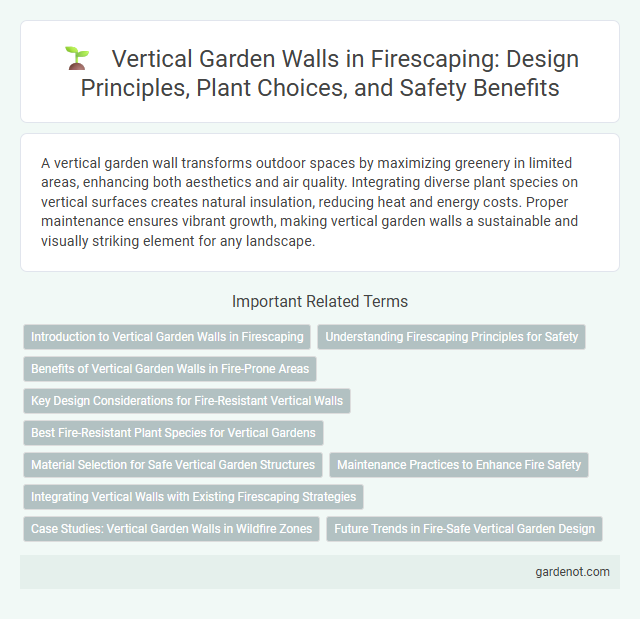A vertical garden wall transforms outdoor spaces by maximizing greenery in limited areas, enhancing both aesthetics and air quality. Integrating diverse plant species on vertical surfaces creates natural insulation, reducing heat and energy costs. Proper maintenance ensures vibrant growth, making vertical garden walls a sustainable and visually striking element for any landscape.
Introduction to Vertical Garden Walls in Firescaping
Vertical garden walls in firescaping enhance property safety by integrating fire-resistant plants and materials that act as natural firebreaks. These living structures reduce flame spread by maintaining moisture levels and minimizing combustible debris near buildings. Incorporating drought-tolerant, fire-resistant species like succulents, lavender, and sage creates a visually appealing barrier essential for effective fire mitigation strategies.
Understanding Firescaping Principles for Safety
Vertical garden walls enhance property aesthetics but require careful firescaping principles to ensure safety. Key factors include selecting fire-resistant plants, maintaining proper spacing, and using non-combustible materials for wall structures. Proper irrigation and regular maintenance reduce fire risk by minimizing dry foliage and debris accumulation on vertical surfaces.
Benefits of Vertical Garden Walls in Fire-Prone Areas
Vertical garden walls act as natural firebreaks by incorporating fire-resistant plants that slow the spread of flames and reduce heat intensity. These green walls enhance property safety while providing insulation that lowers ambient temperatures and improves air quality in fire-prone environments. Integrating moisture-rich vegetation within vertical gardens further increases humidity levels, creating a microclimate that helps inhibit fire ignition and propagation.
Key Design Considerations for Fire-Resistant Vertical Walls
Selecting fire-resistant plant species such as succulents and ferns reduces flammability risks in vertical garden walls. Incorporating non-combustible materials like metal or cement-based panels as backing improves wall fire resistance. Proper irrigation systems maintain plant moisture levels, further minimizing fire hazards in firescaped vertical gardens.
Best Fire-Resistant Plant Species for Vertical Gardens
Selecting fire-resistant plant species such as Sedum, Aloe vera, and Agave is crucial for enhancing safety in vertical garden walls, as these succulents contain high moisture content that limits fire spread. Incorporating native drought-tolerant plants like lavender and rosemary further reduces flammability while providing aesthetic and ecological benefits. Proper plant selection combined with strategic arrangement ensures a sustainable and fire-safe vertical garden environment.
Material Selection for Safe Vertical Garden Structures
Selecting fire-resistant materials such as metal frames, concrete panels, and non-combustible cladding ensures vertical garden walls maintain structural integrity during fire exposure. Incorporating fire-retardant treated plants and soil substrates reduces flammability while supporting healthy vegetation growth. Proper material choice combined with strategic moisture management significantly enhances the safety and longevity of vertical garden installations against fire hazards.
Maintenance Practices to Enhance Fire Safety
Regular maintenance of vertical garden walls, including pruning dry foliage and removing dead plant matter, significantly reduces fire hazards by minimizing combustible materials. Ensuring proper irrigation systems and moisture retention helps maintain plant health and lowers the risk of ignition from heat sources. Using fire-resistant plant species and inspecting irrigation and drainage systems regularly further enhances fire safety in vertical garden installations.
Integrating Vertical Walls with Existing Firescaping Strategies
Integrating vertical garden walls with existing firescaping strategies enhances fire resilience by creating natural moisture barriers and reducing flammable vegetation near structures. Utilizing fire-resistant plant species and non-combustible materials in vertical installations supports effective defensible space management. Proper irrigation and maintenance ensure these living walls maintain high moisture content, further minimizing fire risk while adding aesthetic and ecological value.
Case Studies: Vertical Garden Walls in Wildfire Zones
Vertical garden walls in wildfire zones have demonstrated resilience by utilizing fire-resistant plant species such as succulents, lavender, and rosemary, which reduce flammable vegetation while maintaining aesthetic appeal. Case studies from California and Australia reveal strategic placement of non-combustible materials and irrigation systems that limit fire spread and support plant health under extreme heat. These implementations highlight effective integration of fire-smart landscaping design with sustainable urban greening efforts.
Future Trends in Fire-Safe Vertical Garden Design
Future trends in fire-safe vertical garden design emphasize the integration of non-combustible materials such as metal panels and fire-retardant substrates to enhance structural safety. Advanced irrigation systems with automated moisture sensors are being developed to maintain optimal hydration, reducing the risk of plant desiccation and ignition. Innovations in fire-resistant plant selection, including succulents and fire-retardant greenery, are increasingly prioritized to create aesthetically pleasing yet safety-compliant vertical gardens.
Vertical garden wall Infographic

 gardenot.com
gardenot.com